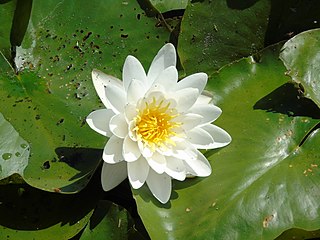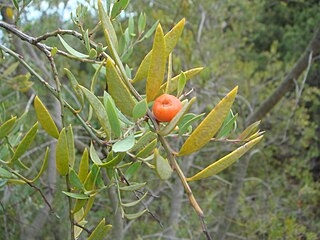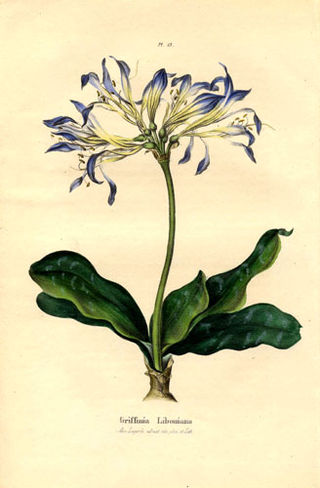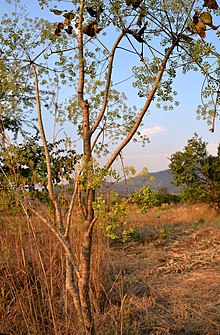
Nymphaea is a genus of hardy and tender aquatic plants in the family Nymphaeaceae. The genus has a cosmopolitan distribution. Many species are cultivated as ornamental plants, and many cultivars have been bred. Some taxa occur as introduced species where they are not native, and some are weeds. Plants of the genus are known commonly as water lilies, or waterlilies in the United Kingdom. The genus name is from the Greek νυμφαία, nymphaia and the Latin nymphaea, which means "water lily" and were inspired by the nymphs of Greek and Latin mythology.

Euryale ferox, commonly known as prickly waterlily, makhana, or Gorgon plant, is a species of water lily found in southern and eastern Asia, and the only extant member of the genus Euryale. The edible seeds, called fox nuts or makhana, are dried, and eaten predominantly in Asia.

Barclaya is a genus of six species of flowering plants of the family Nymphaeaceae. Barclaya are aquatic plants native to tropical Asia. The genus was named in honour of the American-born English brewer and patron of science Robert Barclay.

Brasenia is a genus belonging to the family Cabombaceae, consisting of one species, Brasenia schreberi, commonly known as watershield. It is widely distributed in North America, the West Indies, northern South America, eastern Asia, Australia, the Indian Subcontinent, and parts of Africa.

Nuphar lutea, the yellow water-lily, brandy-bottle, or spadderdock, is an aquatic plant of the family Nymphaeaceae, native to northern temperate and some subtropical regions of Europe, northwest Africa, and western Asia. This species was used as a food source and in medicinal practices from prehistoric times with potential research and medical applications going forward.

Nymphaea mexicana is a species of aquatic plant that is native to the Southern United States and Mexico as far south as Michoacán. Common names include yellow water lily, Mexican water lily and banana water lily.

Xylotheca kraussiana is an African shrub or small multi-stemmed tree in the family Achariaceae. It grows in the sandveld and is widely distributed throughout the eastern parts of Southern Africa, in particular the eastern Transvaal, coastal Natal and Mozambique, preferring the sandy soils of coastal bush and forest.

Steganotaenia is a genus of flowering plant in the family Apiaceae.

Phalaenopsis micholitzii is a species of plant under the phylum Tracheophyta in the family Orchidaceae.This Orchid species is found in mainly four different places in the Philippines Islands. Those four places are Luzon Island, Mindanao, Zamboanga Peninsula and in Camarines Sur near the Isarog mountain.

Osyris lanceolata, also known as African sandalwood, watta bush or Camwood, is used for its scented wood and to extract essential oil. The semi-parasitic plant is found from South Africa to Zimbabwe and east Africa, including Tanzania, Kenya and Uganda; northwest Africa; the Canary Islands and the southern half of the Iberian Peninsula. It grows in rocky areas or along the margins of dry forest, but is usually not abundant in any one place.

Ficus nota is a species of flowering plant in the family Moraceae. It is commonly known as tibig or sacking tree, is a species of fig tree found near water in low altitudes. Tibig is native to the Philippines. They are also found in parts of northern Borneo in Malaysia.The tree can grow up to 9 meters high. It is primarily dispersed by birds which eat the fruits and excrete the seeds. The fruits are also edible to humans, although they are rather bland. They are usually eaten with sugar and cream in the Philippines. The young leaves are also eaten as a vegetable.

Nymphaea micrantha is a water lily belonging to the genus Nymphaea. It is native to the tropics of West Africa.

Griffinia is a genus of Brazilian plants in the Amaryllis family, subfamily Amaryllidoideae. It includes 23 known species which are endemic to Brazil. The most closely related genus to it is the monotypic Worsleya.

Croton sylvaticus is a tree in the family Euphorbiaceae. It is commonly known as the forest fever-berry. These trees are distributed in forests from the east coast of South Africa to Tropical Africa. It grows 7–13 metres (23–43 ft) in height, occasionally up to 30 metres (100 ft), in moist forests, thickets and forest edges at altitudes of 350–1,800 metres (1,100–5,900 ft).

Sclerocroton integerrimus, the duiker berry, is a tree in the family Euphorbiaceae. It is from Southern Africa.

Combretum kraussii, the forest bushwillow, is a medium-sized to large tree in the family Combretaceae. It is found in eastern South Africa, Eswatini and southern Mozambique, in the vicinity of forests. The specific name commemorates Dr. F. Krauss who undertook a collecting trip to South Africa from 1838 to 1840.

Acokanthera oblongifolia is a plant in the family Apocynaceae. It grows as an evergreen shrub or small tree up to 6 metres (20 ft) tall. Its fragrant flowers feature a white tinged pink corolla. The berries are purple when ripe. Its habitat is dry forest and coastal thickets. Acokanthera oblongifolia is used in local African medicinal treatments for snakebites, itches and internal worms. The plant has been used as arrow poison. The species is native to Mozambique and South Africa.

Markhamia zanzibarica, also known as bell bean tree or maroon bell-bean, is a species of plant in the family Bignoniaceae. It is found in East Africa and Southern Africa, from Kenya to South Africa.
Croton macrostachyus is a species of flowering plant native to the mountains of Sub-Saharan Africa.
Allophyllus rubifolius is a species of flowering plant in the family Sapindaceae. It is a shrub or tree native to eastern, east-central, and southeastern Africa, ranging from Eritrea to Democratic Republic of the Congo and Kwazulu-Natal, and to the Arabian Peninsula.



















